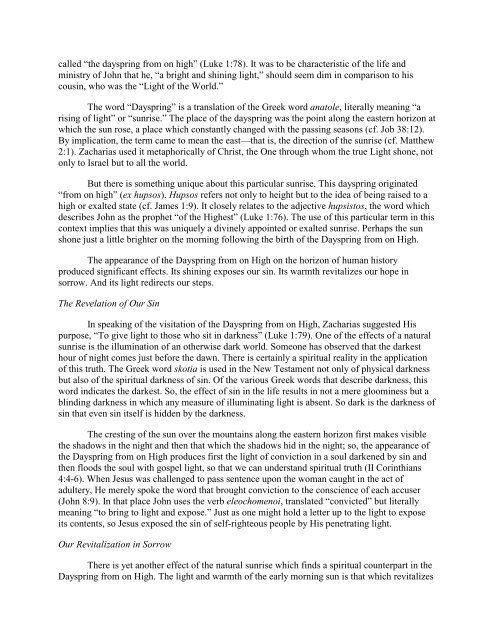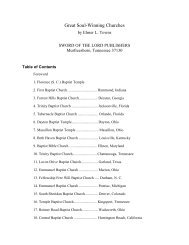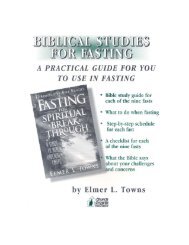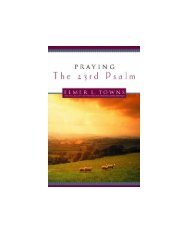The Names of Jesus - Elmer Towns
The Names of Jesus - Elmer Towns
The Names of Jesus - Elmer Towns
- TAGS
- elmer
- towns
- elmertowns.com
Create successful ePaper yourself
Turn your PDF publications into a flip-book with our unique Google optimized e-Paper software.
called “the dayspring from on high” (Luke 1:78). It was to be characteristic <strong>of</strong> the life and<br />
ministry <strong>of</strong> John that he, “a bright and shining light,” should seem dim in comparison to his<br />
cousin, who was the “Light <strong>of</strong> the World.”<br />
<strong>The</strong> word “Dayspring” is a translation <strong>of</strong> the Greek word anatole, literally meaning “a<br />
rising <strong>of</strong> light” or “sunrise.” <strong>The</strong> place <strong>of</strong> the dayspring was the point along the eastern horizon at<br />
which the sun rose, a place which constantly changed with the passing seasons (cf. Job 38:12).<br />
By implication, the term came to mean the east—that is, the direction <strong>of</strong> the sunrise (cf. Matthew<br />
2:1). Zacharias used it metaphorically <strong>of</strong> Christ, the One through whom the true Light shone, not<br />
only to Israel but to all the world.<br />
But there is something unique about this particular sunrise. This dayspring originated<br />
“from on high” (ex hupsos). Hupsos refers not only to height but to the idea <strong>of</strong> being raised to a<br />
high or exalted state (cf. James 1:9). It closely relates to the adjective hupsistos, the word which<br />
describes John as the prophet “<strong>of</strong> the Highest” (Luke 1:76). <strong>The</strong> use <strong>of</strong> this particular term in this<br />
context implies that this was uniquely a divinely appointed or exalted sunrise. Perhaps the sun<br />
shone just a little brighter on the morning following the birth <strong>of</strong> the Dayspring from on High.<br />
<strong>The</strong> appearance <strong>of</strong> the Dayspring from on High on the horizon <strong>of</strong> human history<br />
produced significant effects. Its shining exposes our sin. Its warmth revitalizes our hope in<br />
sorrow. And its light redirects our steps.<br />
<strong>The</strong> Revelation <strong>of</strong> Our Sin<br />
In speaking <strong>of</strong> the visitation <strong>of</strong> the Dayspring from on High, Zacharias suggested His<br />
purpose, “To give light to those who sit in darkness” (Luke 1:79). One <strong>of</strong> the effects <strong>of</strong> a natural<br />
sunrise is the illumination <strong>of</strong> an otherwise dark world. Someone has observed that the darkest<br />
hour <strong>of</strong> night comes just before the dawn. <strong>The</strong>re is certainly a spiritual reality in the application<br />
<strong>of</strong> this truth. <strong>The</strong> Greek word skotia is used in the New Testament not only <strong>of</strong> physical darkness<br />
but also <strong>of</strong> the spiritual darkness <strong>of</strong> sin. Of the various Greek words that describe darkness, this<br />
word indicates the darkest. So, the effect <strong>of</strong> sin in the life results in not a mere gloominess but a<br />
blinding darkness in which any measure <strong>of</strong> illuminating light is absent. So dark is the darkness <strong>of</strong><br />
sin that even sin itself is hidden by the darkness.<br />
<strong>The</strong> cresting <strong>of</strong> the sun over the mountains along the eastern horizon first makes visible<br />
the shadows in the night and then that which the shadows hid in the night; so, the appearance <strong>of</strong><br />
the Dayspring from on High produces first the light <strong>of</strong> conviction in a soul darkened by sin and<br />
then floods the soul with gospel light, so that we can understand spiritual truth (II Corinthians<br />
4:4-6). When <strong>Jesus</strong> was challenged to pass sentence upon the woman caught in the act <strong>of</strong><br />
adultery, He merely spoke the word that brought conviction to the conscience <strong>of</strong> each accuser<br />
(John 8:9). In that place John uses the verb eleochomenoi, translated “convicted” but literally<br />
meaning “to bring to light and expose.” Just as one might hold a letter up to the light to expose<br />
its contents, so <strong>Jesus</strong> exposed the sin <strong>of</strong> self-righteous people by His penetrating light.<br />
Our Revitalization in Sorrow<br />
<strong>The</strong>re is yet another effect <strong>of</strong> the natural sunrise which finds a spiritual counterpart in the<br />
Dayspring from on High. <strong>The</strong> light and warmth <strong>of</strong> the early morning sun is that which revitalizes
















